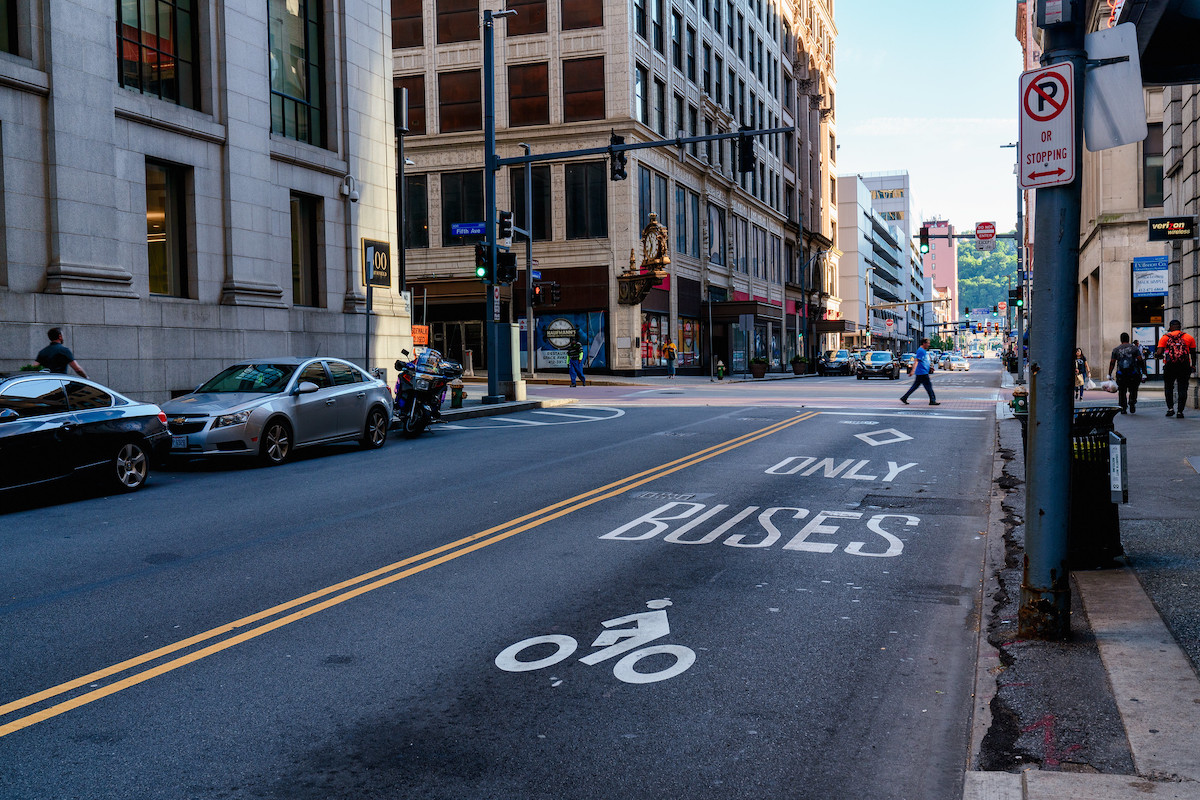Companies might be gearing up to bring employees back to the office, but office occupancy and pedestrian traffic numbers tell a different story.
Last month, Google began publishing and updating a collection of COVID-19 Community Mobility Reports — data for countries and regions across the globe that show how much traffic to places like parks, grocery stores, transit stations and offices changed from baseline data collected in the first five weeks of 2020. Nearly 18 months after initial business shutdowns, Google’s data notes a continued increase in visits to parks along with persistent decreases in use of transit stations or workplaces.
In the most recent update for Allegheny County, park traffic is up 21%, whereas transit stations are down 40% and workplaces are down 43% compared to the initial baseline.
Pedestrian traffic, along with office occupancy levels, has become an important indicator of when (if ever) an appropriate time might be for a broader return to in-person work. Despite widespread access to vaccines in the United States, a significant percentage of the population remains unvaccinated, in part prompting a surge in the Delta variant that has led to renewed business limitations and mask mandates across the country.
The Pittsburgh Downtown Partnership has long been focused on similar metrics, even before the start of the pandemic. While Google’s data shows more general trends, the local organization collects the information at a much more specific level, looking at measurements of office building occupancy, parking garage usage, bus ridership and visits to cultural hubs like Market Square, to name a few. The partnership gathers the data in collaboration with local property owners and managers as well as foot traffic data company Placer.ai and groups like the Pittsburgh Parking Authority and Port Authority of Allegheny County.
Having this data available from years past has helped the Pittsburgh Downtown Partnership and other economy-focused groups gauge when and how a return to in-person work might be possible, Director of Economic Development Initiatives Caitlin Fadgen told Technical.ly.

Caitlin Fadgen. (Photo via LinkedIn)
This summer, many of the numbers have shown a steady increase, with office occupancy reaching an average of 16% in July — doubling from a low of 8% in December of last year. And visits to Point State Park, the largest green area downtown, were higher in July 2021 than they were in July 2019, reaching almost 75,000 people. But given the new spread of the virus, Fadgen isn’t completely confident that the summer’s trends will continue into the fall.
“June was a benchmark, and then it was after Fourth of July was going to be another benchmark to bring more people back, and most recently, after Labor Day is supposed to be the return,” she said. “Of course, we’re not quite 100% certain how that’s going to shake out with concerns over Delta.”
A return to at least some in-person work is especially crucial for Pittsburgh, Fadgen said. In a July 2021 report from commercial real estate information company CoStar, Pittsburgh ranked fifth in the volume of offices taking up square footage in its central business district, putting the city at greater risk of a remote work-related economic downturn than districts more diversely populated with retail, hotels and residential buildings. Though many of the city’s cultural hubs in music, theater and food remain a draw for business downtown, Fadgen acknowledged that “we’re definitely challenged on the real estate end.”
Though uncertain of what new Delta-related restrictions might mean for business, Fadgen shared that several of the companies Pittsburgh Downtown Partnership is in communication with have indicated plans to shift to hybrid work models in the future, as opposed to a full return to in-person. Three of the regions biggest employers — PNC Bank, BNY Mellon and Highmark Health — recently delayed plans to bring employees back to the late fall. And while Fadgen was unable to share specific names of companies discussing these plans, she said she’s heard of some considerations to reduce office footprints in companies’ next lease renewals.
Paired with the current labor shortage in the service industry, Fadgen finds these trends concerning for downtown restaurants and similar attractions. To her, the back-and-forth of planning and projections have started to become a “chicken before the egg thing,” she said. The fewer people who are working downtown might start to note fewer lunch options, for instance — yet more downtown workers would justify more lunch spots staying open.
While Pittsburgh has recently seen some long-term property investments like Hazelwood Green and Rockwell Park start to open to new tenants from the tech industry, Fadgen noted that the landscape of the city’s downtown neighborhood has less space available to redevelop or repurpose.
“We have a lot of office product, but we we don’t necessarily have empty parcels of land where you could build a new office campus or something like that,” she added.
Still, despite the challenges ahead and the continued pushbacks on return dates, Fadgen remains confident that Pittsburgh’s downtown companies will eventually return to in-person work: “Having the physical in-person interaction is so invaluable across the board,” she said. But so long as the spread of the Delta variant looms over that value, “we’re really struggling to grasp what’s going to happen.”
Sophie Burkholder is a 2021-2022 corps member for Report for America, an initiative of The Groundtruth Project that pairs young journalists with local newsrooms. This position is supported by the Heinz Endowments.
This editorial article is a part of How We Work Now Month of Technical.ly's 2021 editorial calendar.
Before you go...
Please consider supporting Technical.ly to keep our independent journalism strong. Unlike most business-focused media outlets, we don’t have a paywall. Instead, we count on your personal and organizational support.
3 ways to support our work:- Contribute to the Journalism Fund. Charitable giving ensures our information remains free and accessible for residents to discover workforce programs and entrepreneurship pathways. This includes philanthropic grants and individual tax-deductible donations from readers like you.
- Use our Preferred Partners. Our directory of vetted providers offers high-quality recommendations for services our readers need, and each referral supports our journalism.
- Use our services. If you need entrepreneurs and tech leaders to buy your services, are seeking technologists to hire or want more professionals to know about your ecosystem, Technical.ly has the biggest and most engaged audience in the mid-Atlantic. We help companies tell their stories and answer big questions to meet and serve our community.
Join our growing Slack community
Join 5,000 tech professionals and entrepreneurs in our community Slack today!

The person charged in the UnitedHealthcare CEO shooting had a ton of tech connections

The looming TikTok ban doesn’t strike financial fear into the hearts of creators — it’s community they’re worried about

Where are the country’s most vibrant tech and startup communities?



